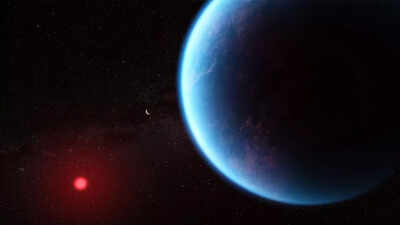ARTICLE AD BOX

In the age of scientific evolution, technological advancements, and space exploration, we have often pondered over this one question for years – is there any planet beyond Earth that could sustain what we know as ‘life’? Any planet that might be habitable for living beings in the future?In April 2025, the scientific community was abuzz with a groundbreaking announcement: astronomers had detected dimethyl sulfide (DMS) in the atmosphere of exoplanet K2-18b, located 124 light-years from Earth.
DMS is a compound produced solely by biological processes on Earth, primarily by marine phytoplankton.This discovery was hailed as the strongest evidence yet of potential extraterrestrial life beyond our solar system. However, just weeks later, scientists are urging caution and emphasizing that the initial excitement may have been premature.Why?While the detection of DMS is intriguing, it does not definitively prove the existence of life on K2-18b.
The compound could also be produced by unknown non-biological processes, and further observations are needed to confirm its origin.
As per Dr. Luis Welbanks, a postdoctoral research scholar at Arizona State University’s School of Earth and Space Exploration, “It was exciting, but it immediately raised several red flags because that claim of a potential biosignature would be historic, but also the significance or the strength of the statistical evidence seemed to be too high for the data.”
What is K2-18b?
K2-18b, classified as a "Hycean" world, is a super-Earth exoplanet, meaning it's larger and more massive than Earth, that orbits a red dwarf star called K2-18. It's located about 124 light-years away from Earth in the constellation Leo.The planet is in its star's habitable zone, meaning it could potentially have liquid water on its surface, according to NASA.The exoplanet has a hydrogen-rich atmosphere and a subsurface ocean.
This environment could potentially support microbial life. In addition to DMS, the James Webb Space Telescope has detected methane and carbon dioxide in the planet's atmosphere, further suggesting conditions that might be conducive to life.However, despite these promising signs and excitement surrounding the same, scientists remain cautious. The detection of DMS alone is not sufficient to confirm the presence of life.As Professor Nikku Madhusudhan, of the University of Cambridge and the lead author of the April study, noted, "We have to question ourselves both on whether the signal is real and what it means."The initial excitement surrounding the discovery of DMS on K2-18b underscores the growing interest in the search for extraterrestrial life. However, it also highlights the complexities and challenges of interpreting data from distant exoplanets. Nikku Madhusudhan and his colleagues have conducted additional research that they say reinforces their previous finding about the planet. And it’s likely that additional observations and research from multiple groups of scientists are on the horizon.The succession of research papers revolving around K2-18b offers a glimpse of the scientific process unfolding in real time. It’s a window into the complexities and nuances of how researchers search for evidence of life beyond Earth — and shows why the burden of proof is so high and difficult to reach.However, the search for life beyond Earth continues.“Are we really alone in this vast universe?”As scientists continue to analyze the data and conduct further observations, the prospective answers to that very question remain open.
Analysis finds evidence for many exoplanets made of water and rock around small stars



.png)
.png)
.png)
















 10 hours ago
7
10 hours ago
7










 English (US) ·
English (US) ·